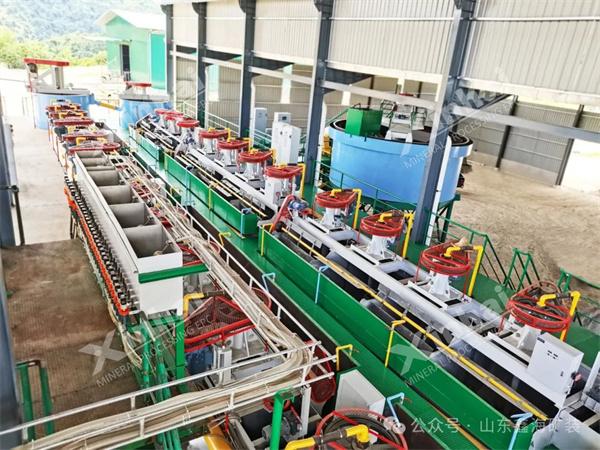Low-grade tin ore refers to tin ore with a tin content of less than 1%. This mineral is mostly in the form of fine particles and has many associated minerals, making it difficult to separate. Traditional single mineral processing technology, such as gravity separation, magnetic separation, flotation, etc., is difficult to achieve a good mineral processing recovery rate. The following are several methods to improve the mineral processing recovery rate of low-grade tin ore for reference only.
(1) Application of combined beneficiation technology
It is difficult for a single beneficiation technology to achieve the ideal beneficiation effect. These technologies can be combined to have certain advantages and can significantly improve the beneficiation recovery rate. The combined beneficiation technologies that are widely used in industry are:
Gravity separation + flotation: firstly, coarse-grained tin minerals are enriched by gravity separation, and then fine-grained tin minerals are recovered by flotation.
Flotation + leaching: after recovering useful minerals by flotation, the valuable metals in the tailings are further recovered by leaching.
Flotation-gravity separation-magnetic separation combined process: firstly, the associated minerals are removed by gravity separation, then the tin minerals are recovered by flotation, and finally, they are purified by magnetic separation.
(2) Optimization of beneficiation process parameters
Through experiments and production practice, the process parameters such as grinding fineness, flotation reagent dosage, and pulp concentration are optimized to improve the beneficiation efficiency. Before designing the beneficiation plan, representative ore samples are taken for beneficiation tests. The tests should involve chemical composition analysis, mineral composition identification, and physical property determination. The mineral processing plan is designed according to the test report. In production practice, it should be adjusted according to the production effect to complete the parameter optimization.

(1)High-efficiency collectors and regulators
The application of new high-efficiency collectors (such as BK411 and BK412) has significantly improved the recovery rate of cassiterite. In addition, the use of environmentally friendly reagents has reduced the impact on the environment.
(2)Improvement of reagent system
Improve flotation efficiency by improving the reagent ratio. For example, the use of new reagent combinations such as alkyl phosphate-sodium silicofluoride has significantly improved the flotation effect of fine cassiterite.
(1)Pre-enrichment technology
Pretreatment enrichment technology can be pre-treated by gravity separation and magnetic separation. Gravity separation can use gravity separation equipment such as jigs, shakers and spiral chutes to pre-select tailings, thereby reducing the processing volume of subsequent separation processes.
The principle of pre-treatment by magnetic separation is to discard iron silicate minerals through strong magnetic separation to improve the grade of selection. Magnetic separation pretreatment methods include wet magnetic separation and dry magnetic separation. Wet magnetic separation can remove iron impurities in ore and improve the purity of tin concentrate. Dry magnetic separation is suitable for processing dry ore and is suitable for smaller-scale concentrators.
(2)Classification and regrinding technology
Grading and treatment according to ore particle size to improve ore dressing efficiency. Regrind difficult-to-select minerals to ensure that the minerals are fully dissociated.
(1)Comprehensive recovery of tailings
Recover valuable metals in tailings through flotation and leaching processes. For example, a mineral processing plant in Yunnan Province has achieved efficient recovery of tin in tailings through wet leaching technology.
(2)Environmental protection treatment of tailings
Secondary separation and resource utilization of tailings, reducing acid consumption through acid circulation process, and realizing the recycling of tailings wastewater.
Improving the recovery rate of low-grade tin ore is a systematic project, which should be adjusted from multiple aspects. By optimizing process parameters, selecting appropriate mineral processing agents, pre-treatment before production, and paying attention to the reuse of tailings resources, the recovery rate of low-grade tin ore will be improved, creating higher economic benefits for enterprises.